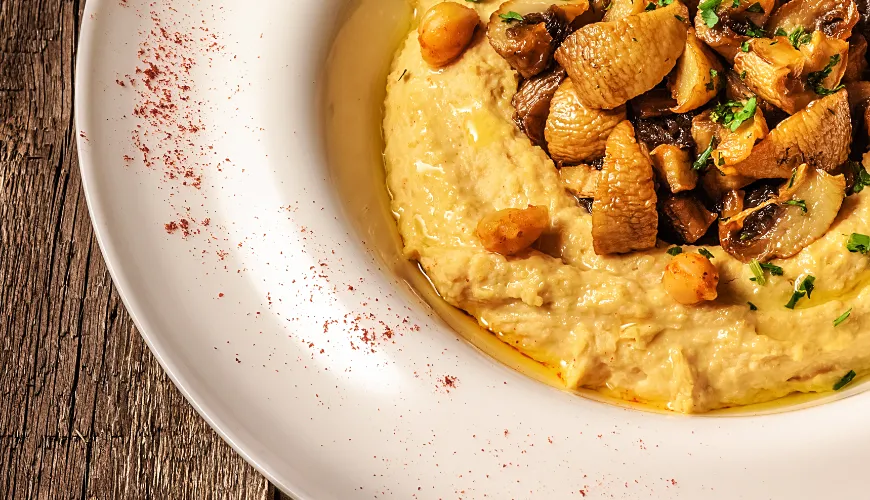
Universal polenta for every occasion

Polenta is a traditional dish that is particularly popular in northern Italy and some other parts of Europe. This delicious cornmeal porridge is not only tasty but also relatively versatile and very nutritious. It can serve as a main dish or as a side. With various preparation and serving methods, it is ideal for any occasion. Whether you prepare it as a simple side or a creative main dish, it will always surprise you with its flavor and versatility. Don't hesitate to experiment and discover new ways to incorporate polenta into your diet.
History of Polenta
The origins of polenta preparation in Europe date back to the 16th and 17th centuries, a time when new crops from America were introduced to Europe. Among them was corn, a staple food of American civilizations that had been cultivated on the American continent for thousands of years. Over the following centuries, the preparation of corn and corn polenta evolved and continued to improve, eventually becoming a staple of Italian cuisine.
Is Polenta Healthy?
Polenta offers a range of health benefits that make it worth including in your daily diet. It contains a rich amount of fiber, which supports healthy digestion and contributes to feelings of fullness, helping to maintain optimal weight. Polenta is also a source of complex carbohydrates that provide lasting energy, a sense of fullness, and stabilize blood sugar levels. Additionally, it contains some important vitamins and minerals, such as vitamins A, C, and magnesium, which support the immune system and overall health. For those seeking a gluten-free alternative, polenta is an ideal choice as it is naturally gluten-free.
Basic Polenta Preparation
Preparing polenta is easy and quick. There are two main ways to prepare it: instant polenta and traditional method.
Instant Polenta
For a quick and easy preparation, you can use instant polenta. For one serving, you need 100 grams of polenta and 1 liter of water. In a non-stick pot, bring salted water to a boil and gradually add the polenta while stirring continuously. Cook on low heat until the polenta thickens. For a creamier consistency, add two tablespoons of olive oil or butter.
Traditional Polenta Preparation
Traditional polenta preparation requires a bit more time and patience, but the reward is a richer flavor. Use 100 grams of cornmeal for 600 ml of water. Follow the same steps as with instant polenta, but cook for a longer time, about 45 minutes, until the polenta is beautifully smooth.
How to Serve Polenta?
Polenta is an exceptionally versatile dish. It can be served in various forms – as a soft porridge, a firm slice, or even grilled. Don’t hesitate to try out different creative ways to serve polenta.
Soft Porridge
Soft polenta is ideal as a side to stewed meats or ragù. Its creamy texture perfectly complements flavorful sauces, creating a harmonious dish.
Firm Polenta
For firm polenta, use less water when cooking and let it cool in a mold. Then, you can cut it into slices and serve it as a side or a base for other dishes, such as baked polenta cakes.
Grilled Polenta
Grilled polenta is an excellent option for summer barbecues. Cut the firm polenta into slices and grill them in a bit of oil until golden brown and crispy. It pairs wonderfully as a side to meat or vegetable salads.
Polenta in Modern Cuisine
Polenta is becoming an increasingly popular component of modern cooking. Thanks to its simplicity and versatility, chefs can easily adapt it to their needs and creativity. You can use it as a base for various types of dishes, from breakfasts to desserts.
Soft polenta can be a great alternative to traditional oatmeal. Add fresh fruit, honey, or nuts, and you have a healthy and tasty breakfast. Combining polenta with grilled vegetables, cheese, or meat creates a balanced and nutritious main dish. For example, try polenta with spinach and parmesan or with grilled mushrooms and garlic.
Polenta as Dessert
Yes, sweet polenta can also make an excellent dessert. Cook it with milk and sugar, add vanilla, and serve it with fruit sauce or chocolate. This unconventional dessert is sure to surprise and delight your guests.
Don't Be Afraid to Experiment with Polenta
Don't hesitate to experiment with various recipes and preparation methods for polenta. You can combine it with different types of vegetables, cheeses, meats, or sweet ingredients to suit your taste preferences and dietary needs. Polenta is truly a versatile dish worth exploring and incorporating into your daily diet. It is also a great way to add more whole grains to your meals and increase your intake of essential nutrients. It is rich in complex carbohydrates that provide stable energy throughout the day.
Whether you are an experienced cook or a beginner in the kitchen, polenta offers endless possibilities for creative and tasty cooking. From simple sides to more complex dishes, its versatility and easy preparation make it an ideal choice for any meal plan. So why not try something new and add polenta to your culinary repertoire? And if you’re looking for more alternatives using corn and thus naturally gluten-free, you can also try corn flours and grits.

